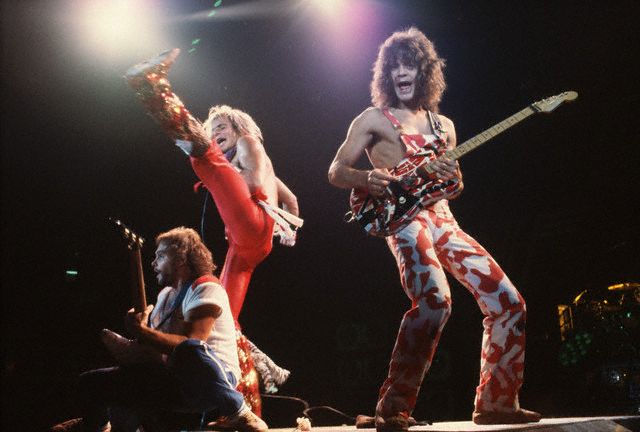An Analysis of the Diver Down album and “Hide Your Sheep” Tour
By Scott Essman
This year marks the 30th anniversary of Diver Down, Van Halen’s fifth album. Some are quick to criticize the album because it contains several covers. However, Diver Down had moments that matched the brilliance of nearly anything the band has released, and 1982 was one of the most spectacular years in the band’s history.
After the formidable Fair Warning album and tour in 1981, the fourth time that the band unleashed its fury on vinyl and across arenas in the U.S and abroad, the spring of 1982 was destined to be a letdown. Fair Warning had been the band’s best album to that point, and although its sales might have been below those of the first three albums, the live performances from that album made for the perfect realizations of Van Halen Mark 1 ever captured. How can a band follow up such outstanding artistic success? First, they did not try to recreate Fair Warning with the next collection. In fact, the dark serious tone of Fair Warning was all but abandoned in favor of a much poppier sound, a trend which would continue to greater extremes on the 1984 album and again with VH Mark 2 and the 5150 album.
Underscoring singer-lyricist David Lee Roth’s comment that “if you have a message, use Western Union,”
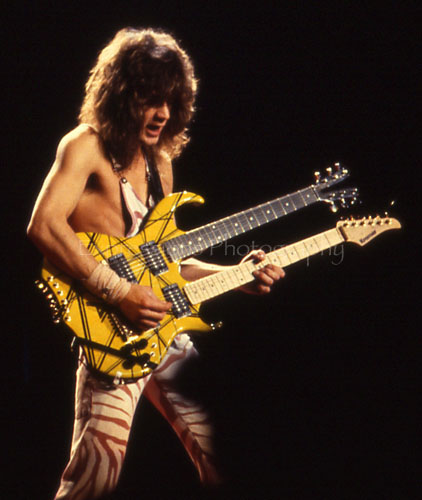
The First Single
the pop approach of Diver Down might have indicated a steering away from the intensity of such Fair Warning songs as “Mean Street,” “Dirty Movies,” “Hear About it Later,” “Unchained,” and “So This is Love?”, but that did not tell the whole Diver Down story. In fact, the album cover carefully inserted an approach that, unlike the first three albums, more resembled Fair Warning: the red-with-white-striped diver’s flag adorned the entire front side. The curious choice was explained by Roth in follow-up interviews in which he stated that there might be something that you don’t immediately see underneath the surface, or “what you think is nothing might be something after all,” as he stated on “Mean Street.”
Of course, the first song released from the album was a standalone single, the cover tune, “Pretty Woman,” which Roy Orbison had written and recorded in 1964. Released with the Van Halenized single was an outrageous conceptual video that fashioned the four Van Halen band members as rescuers of a damsel (?) in distress who calls for help after her capture by two little people. Bassist-background vocalist Michael Anthony was a samurai warrior, drummer Alex Van Halen was a Tarzan figure, guitarist-background vocalist Edward Van Halen was a Lone Ranger-style cowboy, and Roth was the reincarnation of French leader Napoleon. The revelation of the damsel as a female impersonator caused such a fuss, that it was later banned by MTV. But, when it first aired during DJ Jim Ladd’s nationally broadcast interview with Roth at his Pasadena mansion in early 1982, it caused a giddy stir among Van Halen fans. Intercut with the Ladd interview and the debut of the “Pretty Woman” music video were the debut of concert performances of “So This is Love?” “Hear About it Later,” and “Unchained” from the two-night Oakland stand of the Fair Warning tour. To this day, many fans consider those three videos remain the pinnacle of recorded live performances of the band from their entire career.
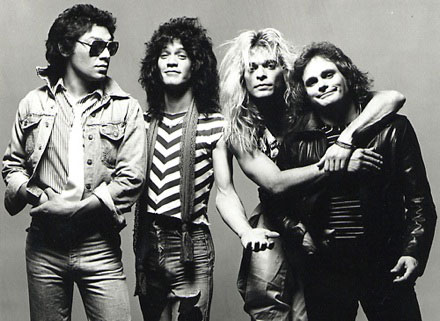 The Album
The Album
Although the album clocks in at just over 31 min in length (VH’s shortest album), it’s filled with some of the most scintillating and diverse material of the band’s career.
Warner Bros., Van Halen’s record company at the time, was so enamored with the “Pretty Woman” single that they pressured the band to record a full album so as to release an entire package. Thus, Diver Down entered history as their rushed, unplanned album which fans sometimes dismiss as “their album with all the covers.” However, though the album contained several covers and was quickly recorded and rushed into production, those factors didn’t hinder its success. For instance, the band had often bragged about recording the album Van Halen II in six days, pointing out amusingly that the album had “mistakes” if one listened carefully. With Van Halen II being a renowned classic, it’s clear that taking their sweet time is not a factor of Van Halen’s excellence. Next, the fact that Diver Down had many covers is true, but it’s easy to forget that the first album, Van Halen, had two covers that were so significant that they played huge roles in the band’s success and live shows to this day. Moreover, VH II’s first track is a cover, which does not seem to tarnish that record either.
The Covers
Diver Down kicks off with a rendition of the Kinks’ 1965 song, “Where Have All the Good Times Gone!” Is the band lamenting the bygone 1970s, or perhaps longing for the more carefree earlier times in their own ascent to the top of the rock scene? The first crescendo leads to all four band members showing themselves as a tight unit: Alex Van Halen’s pounding drums perpetually up in the mix, Michael Anthony’s melodic pulsing bass lines, and Eddie Van Halen’s soaring guitar sound, arguably “more brown” than Fair Warning. Michael’s and Eddie’s combined background vocals offset Roth’s lead vocals, asking what has happened to happier times. Where on Fair Warning, Roth’s lines were more spoken-word than the high-pitched shrieking of the first few Van Halen albums, on Diver Down, he’s back to his melodically-pitched cries.
After “Pretty Woman” closed side 1, the listener would flip the record or cassette over to find the third Diver Down cover, “Dancing in the Street,” a Motown song originally recorded by Martha and the Vandellas in 1964 (interesting note that these first three covers all originally came out within two years). On first glance, one might wonder why Van Halen would record a Motown song, but the intro indicates the answer steadfastly: Edward Van Halen conjures yet another remarkable sound from his guitar: one that listeners were sure was created by some manner of keyboard or synthesizer. Yet actually, the intro to “Dancing in the Street” is wholly and magically manifested by a guitar! [VHND notes: Our writer was incorrect here…Ed used a Mini Moog synthesizer in conjunction with his echo guitar on this song]. A close audio analysis indicated more than one guitar track, with several amazing sounds being made by Edward and his prized six strings. The fact that the man was able to bring forth such a sound from a stringed instrument is amazing in and of itself, but the type of sound that serves as the lead melodic instrument in the song is nothing short of mesmerizing. One more note about Edward’s playing on “Dancing in the Street”: the technique being used is surely one notable aspect, but over and above that, he is not really playing lead or rhythm guitar with his stunning guitar lines; it is something different, at once a melody, but not related to the vocal – what it is, exactly, defies description and could not have been brought to life by any other guitarist on planet earth. As such, Edward stands alone with two other players in history for his sheer ability to come up with material that no one else before or since: Jimi Hendrix and Tom Morello. Together, those three have been on a separate plane from any musicians who have picked up a guitar.
The next full cover is a 1924 song by Milton Ager with lyrics by Jack Yellen — “Big Bad Bill (Is Sweet William Now)”. This song would become legend as the one occasion where Edward and Alex got to play with their musical inspiration, forefather, and mentor: their Dutch father, Jan Van Halen. Himself a career musician, Jan played the clarinet and fit right in with his multi-talented sons. A fun song which brings the Van Halen brothers together with their father for the one and only time on record.
The last cover, and not a full song, is the a cappella version of “Happy Trails,” written by Dale Evans and first recorded by Evans and Roy Rogers in 1952. Only a minute, five seconds, the ditty is merely a fun way for the entire band to harmonize (as they always did in their mid-1970s club days), ending with the group breaking up in laughter, similar to what one would hear on earlier songs like “Bottoms Up”. “Happy Trails” made a great encore on the “Hide Your Sheep” tour.

The Instrumentals
If Diver Down has an undoubted strength, it is the inclusion of some of Edward Van Halen’s most amazing instrumental solo work. The third song on the album, “Cathedral,” surely sounds like a pipe organ until you realize that it’s entirely Edward and a guitar. The “Hide Your Sheep” tour and those which have come since revealed that he was tapping the strings with his four main fingers on his left hand while simply working the volume button with his right hand, lowering the volume when a string was tapped and raising it for the aftermath. The coordination of volume and tap eliminated the “guitar” sound and created the illusion of some sort of electric piano device which human ears had never before heard. Thus, before another track came on, just on the strength of “Cathedral” alone, Diver Down was not only the “brownest” but also the most beguiling sounding record to date in Van Halen’s career. Multiple plays would be necessary to decipher what was going on, as Roth said, under that surface, especially because the tune is so quickly and melodically rendered. It also underscored the reality that when your team includes the best guitar player in existence, one who very rarely repeats himself on record, you are guaranteed something special every time out.
The next instrumental, fashioned as a lead-in to “Pretty Woman,” was “Intruder,” a cousin to “Sunday Afternoon in the Park” from Fair Warning. With Alex’s omnipresent drums, Michael’s prominent bass, and Edward’s ominous, shrieking guitar sounds, the song does indeed conjure the image in its title. Note that Roth has taken credit for playing the underlying synthesizer for this track.
The last instrumental, and another of the band’s all-time best, is the intro to “Little Guitars,” played by Eddie on an acoustic guitar. The 42 seconds are again unimaginable: after a brief opening that sounds like a Spanish guitar exercise, Edward goes into a spell where he rapidly strums with his right hand while playing separate notes by tapping with his left. Again, one assumed that he was either overdubbing two separate guitar parts or had another player (although highly unlikely), because how else to get two totally separate leads on one guitar at the same time? One would have to wait until the tour to figure it out,
but in the heart of hearts of Van Halen’s audience, we knew that somehow it had to be all done at once. One must conclude that Edward’s years of training on piano led to this approach.

The Originals
If stunning covers and instrumentals were not enough to satisfy even casual Van Halen fans, the album’s originals would do the trick. Though the aforementioned pop direction was becoming apparent, the four non-cover/non-instrumentals on Diver Down rank among the best original material the band ever recorded. First up, with track two, is “Hang ‘Em High.” Based on a 1968 Clint Eastwood film of the same name, ostensibly, the theme came from Roth, who admitted to being an ardent movie fan. The muscled repetitive drive of the song recalls two similar tracks from the two previous Van Halen albums: “Loss of Control” from Women and Children First, and “Sinners’ Swing” from Fair Warning. The combined band sound is top notch, and the guitar playing sizzles throughout, especially the lead. In the annals of VH Mark 1, “Hang ‘Em High” might represent one of their heavier sounding songs, not only with Edwards fast-paced playing, but with the rhythm section’s unmatched prowess.
One of Van Halen’s lighter songs, but among the best of its kind, is the next original on Diver Down, “Secrets.” More melodic than other notable lighter VH fare such as “Little Dreamer” from Van Halen or “Push Comes to Shove” from Fair Warning, “Secrets” has a tender approach, with the whole somehow being greater than the sum of extraordinary parts: witness Alex’s steady reinforcing beat, Michael’s tender bass-line, Edward’s flanging lead guitar playing, and Roth’s sweet lyrics, an ode to some unnamed fantasy woman. But much more is going on: the little outro by Edward and Michael after each verse; the way that Michael and Eddie’s perfectly pitched background vocals first come in during the second chorus; Roth’s fetching sense of longing during the bridge (possibly double-tracked). By the third verse, the listener is fully engulfed, but before another chorus, Edward delivers a solo, which as a piece, sounds very much like the one in “Beat It” that same year. After a last chorus, the song ends just as delicately as it began, and thus is delivered perhaps Van Halen’s best-recorded softer-crafted song to that point.
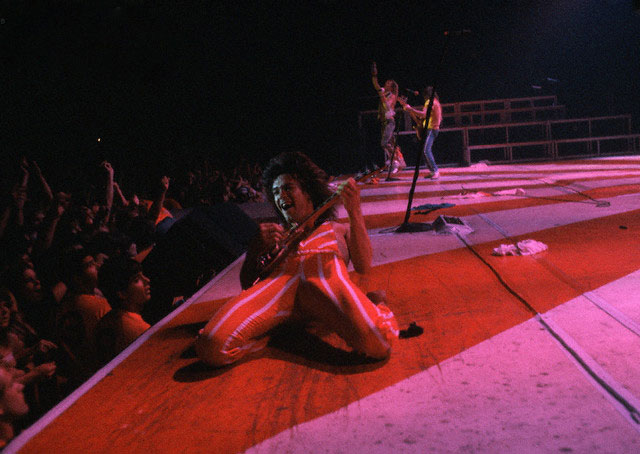
If the album has a true sleeper, it is the next original, “Little Guitars,” which immediately follows its previously-named intro after a short beat. But in a way, the opening 49 seconds of the song are yet another instrumental, a beautifully set-up section unmatched by any Van Halen song opening outside of “Women in Love” from Van Halen II for its sheer tenderness. A counterpart of sorts to “Secrets,” the song is another tribute to a distantly-observed woman, and despite the faster pace than the former, is another upbeat non-threatening song. And like “Secrets,” “Little Guitars” has an unforgettable vibe: the combination of Edward’s brightly tapped-out guitar lines is complemented by Roth’s vocal approach and lyrics which embody a character in the song who desperately loves the woman in question but cannot directly approach her. Edward and Roth offset the relatively basic bass-drum parts that are steady but never complicated or overreaching as they provide the perfect foundation for the pretty guitar-vocal section. Again, Edward and Michael provide the ideal background vocals for select sections of the verses, nicely countering Roth’s lead vocal lines. The song is so able on its own terms, no guitar solo is needed and, as such, one wasn’t used. The overall effect is such a delight, that when the end section comes in with Roth’s crooning away (no additional words were needed), the listener is left wanting more, much more. After Roth concludes his section, Edward is left alone to provide some closing statements of his own on the proceedings, echoing the instrumental 49-second opening. With under three minutes of the actual total meat of the song, “Little Guitars”’ only imperfection is that one doesn’t have more music to absorb. In Van Halen’s entire catalogue, there might not be any more complete a piece. Of note, in the live shows with Roth in 1982 and 1984, the band played an extended version of “Little Guitars” which elongated the outro of the song by repeating it several times, following a new section with a slowed-down chorus section including Roth’s “… sing to me… talk to me” that fit in with the construction of the original song.
The last original song on the Diver Down set is “The Full Bug,” a balls-out blues number that is one of the deeper cuts on the album, but one of the best. All four members are rocking out to the hilt. While more heavy blues than heavy metal, Edward stars with a complex guitar lead while Roth offers “the best part of a man.” Edward’s solo doesn’t scorch so much as recall his verse sections, followed by a Roth harmonica solo that burns. Before the last verse, Roth plays alone with Edward before the full band launches into one final smoking chorus that begs the question of why the band never again recorded a hard-edge number in the same vein as this ultimate rocker. Again, “The Full Bug” represents one of the finest of tunes in the Van Halen catalogue. And just like that, the album is over.
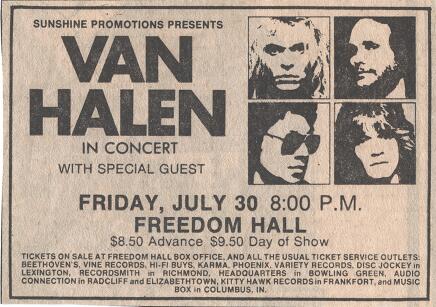 The Tour
The Tour
The Fair Warning tour had long been over when Diver Down was recorded, and the requisite “Hide Your Sheep” tour to support the latter collection was carefully planned and became the band’s most ambitious to date, only usurped by the 1984 tour two years later. In fact, the 1982 tour was so carefully modulated by the band, Eddie Van Halen even had time to record the guitar solo for “Beat It’ on Michael Jackson’s Thriller. In an odd coincidence and a display of Van Halen’s ubiquity in music of the 1970s and 1980s, Edward’s appearance on “Beat It” helped Jackson cross over from R&B to rock audiences, propelling Thriller to number one, but later preventing Eddie’s own band from reaching the top spot when 1984 hit the charts.
If you want to discern which photographs from the band’s canon were taken on the 1982 “Hide Your Sheep” tour, look for Edward in overalls.
One of the visual signatures of the band’s 1982 “Hide Your Sheep” tour were Edward’s overalls. He wore red overalls with white stripes, red overalls with white splotches, and white overalls with red splotches on this tour. Also look for rocket silo formations in Alex’s bass drums. This tour, an outgrowth of the Fair Warning tour, featured an astonishing lighting setup where spotlight runners were overhead in huge rigs which would come down upon the stage, spin, and turn to highlight band members in different areas of the stage. Now a polished machine, Van Halen live in 1982 was a wonderment. During that tour, Alex was 29, Michael was 28, Roth was turning 29, and Edward was just 27. At their peak at this time, the band gave an unrelenting show of songs culled from the first five albums, with an emphasis of course on Diver Down. Aside from “Dancing in the Street” and “Big Bad Bill,” the entire album was played, instrumentals and all. 23 songs filled the set list, in addition to Edward’s lengthy solo (Michael and Alex also took a solo, and Roth did a strobe-like martial arts dance). For “Little Guitars,” Edward brought out a – small guitar – and during his solo, he ran up and down the many platforms onstage from stage left to right, up and down Alex’s drum riser and all. The tour was unquestionably a wild time onstage for Van Halen’s band members, but an equally stirring experience for their audience. A good example of the tour can be found with a glimpse of Van Halen’s US Festival appearance during Memorial Day Weekend, 1983, a seminal event in the band’s history. The stage set had changed by then, but much remained the same from the “Hide Your Sheep” tour, one of the finest of its time, and in a period just before the band became international monster stars.

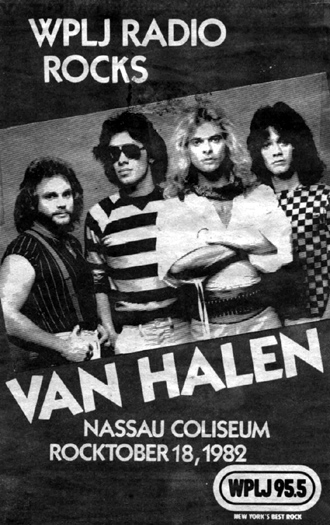 Postscript:
Postscript:
This author was 15 when Diver Down was released and 16 when they announced the “Hide Your Sheep” date at the local arena, the Nassau Veterans’ Memorial Coliseum on Long Island, New York. Then, the unthinkable happened. While the author was collecting supermarket carts in the parking lot of the hometown grocery store, it was announced that Van Halen’s October 18 date, for which tickets were sold and promotion already had gone out, there would be a postponement. Edward broke a pinky finger horsing around in a New York hotel room (the band had played Madison Square Garden on October 8). When one is fifteen, a 26-day postponement is an eternity, anticipating a date which would seemingly never come. Alas, it was all worth it when the band finally played on November 13. During the opening number of “Romeo Delight,” in the first chorus, Roth announced, “We’re sure glad we made this one up, Nassau!” and this author’s three friends and he knew they were in good hands. Also, this author’s clique was sitting in sixth row floor seats, slightly stage left, which was also Eddie’s side. One can only imagine the combination of excitement, glee, and musical recklessness felt by a 16-year-old at the time, a feeling which has never left. In fact, this author moved into the Van Halen home-base of the Pasadena area of the San Gabriel Valley, California, in the former hometown of Michael Anthony (up until just recently), a town whose steep mountain road is immortalized by the lyrics, “I lost a lot of friends there baby; I got no time to mess around.” Thus, one can comfortably state that Diver Down had a profound influence on this author’s life, an impact which has never fully left.
